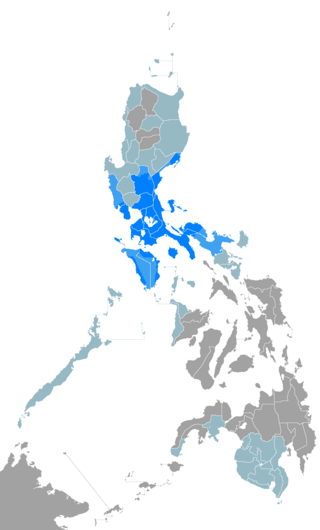| Tagalog | |
|---|---|
| Wikang Tagalog | |
| Pronunciation | [tɐˈɡaːloɡ] |
| Native to | Philippines |
| Region | Katagalugan; Metro Manila, Parts of Central Luzon, Most of Calabarzon, Parts of Mimaropa, and Northwestern Bicol Region |
| Ethnicity | Tagalog |
| Speakers | L1: 29 million (2010)[1] L2: 54 million (2020)[1] Total: 83 million[1] |
Early forms | |
Standard forms | |
| Dialects | |
| |
| Official status | |
Official language in | Philippines (as Filipino)
ASEAN (as Filipino) |
Recognised minority language in | Philippines (as a regional language and an auxiliary official language in the predominantly Tagalog-speaking areas of the Philippines) |
| Regulated by | Komisyon sa Wikang Filipino |
| Language codes | |
| ISO 639-1 | tl |
| ISO 639-2 | tgl |
| ISO 639-3 | tgl |
| Glottolog | taga1280 Tagalogictaga1269 Tagalog-Filipinotaga1270 Tagalog |
| Linguasphere | 31-CKA |
 Predominantly Tagalog-speaking regions in the Philippines | |
Tagalog (/təˈɡɑːlɒɡ/, tə-GAH-log;[4] [tɐˈɣaː.loɡ]; Baybayin: ) is an Austronesian language spoken as a first language by the ethnic Tagalog people, who make up a quarter of the population of the Philippines, and as a second language by the majority, mostly as or through Filipino. Its standardized, codified, national or nationalized, intellectualized, more linguistically inclusive, more linguistically dynamic, and expanded or broadened form, officially named Filipino, is the national language of the Philippines, and is one of the latter's two official languages, alongside English. Tagalog, like the other and as one of the regional languages of the Philippines, which majority are Austronesian, is one of the auxiliary official languages of the Philippines in the regions and also one of the auxiliary media of instruction therein.
Tagalog is closely related to other Philippine languages, such as the Bikol languages, the Bisayan languages, Ilocano, Kapampangan, and Pangasinan, and more distantly to other Austronesian languages, such as the Formosan languages of Taiwan, Indonesian, Malay, Hawaiian, Māori, Malagasy, and many more.
- ^ a b c Tagalog at Ethnologue (27th ed., 2024)

- ^ Manuel, E. Arsenio (1971). A Lexicographic Study of Tayabas Tagalog of Quezon Province. Diliman Review. Archived from the original on February 24, 2024. Retrieved February 24, 2024.
- ^ "The Morphology of Sox-Tagalog". medium.com. Retrieved November 3, 2024.
- ^ According to the OED and Merriam-Webster Online Dictionary Archived January 21, 2018, at the Wayback Machine